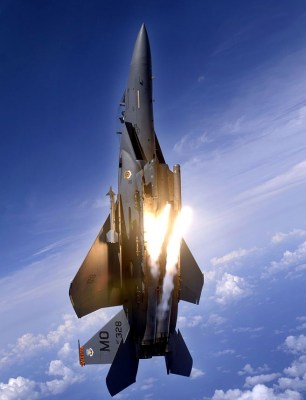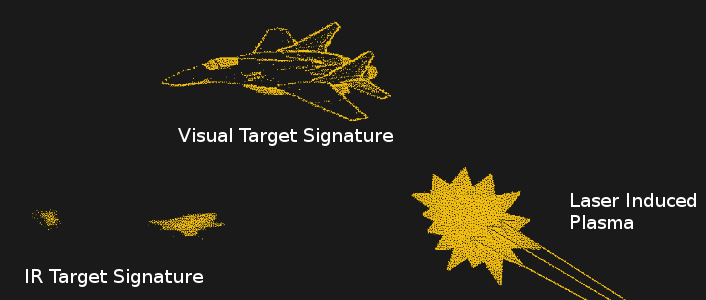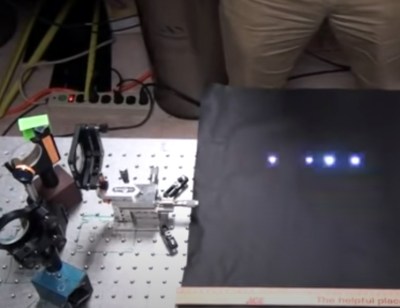Air-to-air combat or “dogfighting” was once a very personal affair. Pilots of the First and Second World War had to get so close to land a hit with their guns that it wasn’t uncommon for altercations to end in a mid-air collision. But by the 1960s, guided missile technology had advanced to the point that a fighter could lock onto an enemy aircraft and fire before the target even came into visual range. The skill and experience of a pilot was no longer enough to guarantee the outcome of an engagement, and a new arms race was born.

Naturally, the move to guided weapons triggered the development of defensive countermeasures that could confuse them. If the missile is guided by radar, the target aircraft can eject a cloud of metallic strips known as chaff to overwhelm its targeting system. Heat-seeking missiles can be thrown off with a flare that burns hotter than the aircraft’s engine exhaust. Both techniques are simple, reliable, and have remained effective after more than a half-century of guided missile development.
But they aren’t perfect. The biggest problem is that both chaff and flares are a finite resource: once the aircraft has expended its stock, it’s left defenseless. They also only work for a limited amount of time, which makes timing their deployment absolutely critical. Automated dispensers can help ensure that the countermeasures are used as efficiently as possible, but sustained enemy fire could still deplete the aircraft’s defensive systems if given enough time.
In an effort to develop the ultimate in defensive countermeasures, the United States Navy has been working on a system that can project decoy aircraft in mid-air. Referred to as “Ghosts” in the recently published patent, several of these phantom aircraft could be generated for as long as the system has electrical power. History tells us that the proliferation of this technology will inevitably lead to the development of an even more sensitive guided missile, but in the meantime, it could give American aircraft a considerable advantage in any potential air-to-air engagements.
Looking the Part
At first blush, the idea sounds like something from science fiction. Volumetric holograms projected into thin air have been the Holy Grail of display technology for decades, and the idea that the Navy has developed the concept far enough that they can bolt it to the back of an aircraft might come as something of a shock. But the important distinction here is that the projection isn’t trying to fool human eyes. It’s probably best to think of the projection as a solid-state replacement to the traditional flare: the idea is create a mass of plasma in the air that is emitting enough energy at the appropriate wavelengths that it would distract from the physical aircraft it’s being projected from.

But that doesn’t necessarily mean the projection will be an amorphous blob, either. The patent specifically mentions that the system’s 248 nm krypton fluoride (KrF) laser could be paired with mirrors and raster optics to create 2D and 3D volumetric images in space. It goes on to compare the technique with the way images were drawn with a scanning electron beam in a cathode-ray tube television.
So while the projection wouldn’t visibly resemble an actual aircraft, it could be given a three dimensional shape to better approximate a jet engine or fuselage. This is a critical improvement over traditional countermeasures, as more advanced guided missiles such as the AIM-132 now include thermal imaging technology that can differentiate between a hot “point source” like a flare and the more nuanced shape of an aircraft.
Laser Light Show
As it so happens, the technology to project relatively simple geometric shapes in the air with a laser isn’t exactly new. A Japanese company demonstrated using laser-induced plasma balls as “pixels” in a rudimentary display as early as 2011, with plans to use it for advertisements and emergency notifications. While the technology offered limited resolution, it was more than sufficient to draw shapes and text that were visible even in daylight.
The concept is also very similar to a research being conducted by the Department of Defense into open-air plasma speakers. Developed as part of the Joint Non-Lethal Weapons Program, the light and sound produced by the plasma ignition was envisioned as a way to stun or confuse a target. One demonstration even showed how the plasma ball could be modulated in such a way that they could emit an audible warning message.
Phantom Fliers
Looking at existing laser-induced plasma experiments, the Navy’s idea suddenly seems a lot more reasonable. While packing a powerful enough laser and associated optics into a package small enough to mount to a fighter jet may still be a few years away, it seems clear that the concept itself is sound.

The advantages of such a system over traditional flares are considerable. As already mentioned, this type of countermeasure wouldn’t be consumable. Chaff and flares need to be carefully rationed with the help of automated dispensers, but so long as the turbines are spinning and the plane has sufficient electrical power to operate the laser, the projection can remain active.
Another key improvement is that the plasma decoy will actually follow the aircraft as it flies. Corporeal countermeasures are quickly left behind, but these ghosts would be able to maintain a set distance from the aircraft throughout the entire mission.
So what happens when aircraft are able to project plasma ghosts behind them that make them invulnerable to heat-seeking missiles? It seems the next logical step would be to develop missiles that use visual identification for terminal guidance. At that point you’d need an emitter that can project a decoy that actually looks like a real airplane, in which case we might actually get that fabled holographic display technology before too long.
















Tom,
include a link to the Hackaday article about the B-52 chaff dispenser.
Not even a “coil you please”?
Where are my manners?!
Tom, coil you please include a link to the Hackaday article about the B-52 chaff dispenser?
Always remember your manners and include a solenoid
sudo include a link to the Hackaday article about the B-52 chaff dispenser.
package include not installed
you might want to run ‘sudo apt-get install include’
HAHA! Nice!
Never mind!
https://hackaday.com/2018/07/24/milspec-teardown-c-1282-chaff-controller/
You know it’s funny. The whole time I was writing this, I kept thinking “Got to make sure I include a link to the B-52 chaff dispenser at some point” and yet I somehow forgot. The situation has now been rectified.
Well, before Wilbrus posts another reminder for me…
Thank you Tom, for including a link to the Hackaday article about the B-52 chaff dispenser.
This is actually pretty easy to demonstrate with (relatively) cheap Q-switched Nd-YAG laser. I tried it with a 400 mW (average) laser that produced “only” 12 MW pulses. With a suitable lens it could throw a dot in air 30 cm away, but it wasn’t powerful enough to put it 1 m away: there’s very definitely a threshold electric field strength needed to produce the spark. It was a neat party trick to blast holes in business cards. Eye-safe it ain’t.
For the air countermeasures, I’d guess you would need to produce a plane-size collection of thousands of dots at a few hundred meters range. With the laser power and pointing precision you would need to produce that I wonder why you would bother: you could ablate the lens of an oncoming missile or even blind the bad guy’s plane directly.
That’s a good point about the laser power. I’m sure there are already measures in place for handling safe tests of laser ranging and targeting systems on the ground, but the fast scan rate of the countermeasure laser would probably mean Laser goggles would become a very standard ground crew item.
I like the suggestion of targeting a seeker head with a laser to attempt to ablate or destroy the optics. The difficulty is that the method mentioned above only requires a fast scanning laser system that can ‘paint’ its 3D picture. This method is almost a passive system (other than changing the format, location, size and power of the ‘image’). A system that can target a missile means mounting a guiding system that may itself act as a beacon for an enemy targeting system.
Anti-missile laser systems have already been deployed on ships but these target the missile motor and/or warhead since anti-ship missiles are usually Radar or TV guided. When you’re sat in a great hunk of metal you’re less worried about blasting targeting radar at an object since everyone can see your massive radar return and your own active radar systems anyway.
As someone who knows more than a little bit about DIRCM and the state of airborne lasers, ablating the lens of incoming is actually a HUGE waste of energy, instead what you do is dazzle them. Blasting a lot of light down their optics stack and swamping the detector or creating off-axis Narcissus Effect images is FAR more efficent than trying to keep tack-sharp focal point tracking of a rapidly incoming munition.
But you have to keep doing it, and there could be more than one incoming missile. If you have the laser power it may be preferable to just fry the detector and move on to the next threat.
So, now we know what those mysterious lights are often reported in the skies of the Western U.S.
Seems like an updated Houndog and Quail in the form of a small missile would work too but a finite resource as stated above. I have serious reservations as to how well this will work with AR and AI targeting systems. Once there is a discernable pattern, then this will be rendered a useless light show.
I thought there was stuff in existence that homed on sources of coherent light as a defence against laser targeted munitions, so I can’t see how this won’t be of limited use from the get go.
It’s called an arms race for a reason. Everything is of limited use, the key thing is how limited and what it forces the opposition into having to develop to defeat. The biggest benefit comes from the cost comparison. Can I spend less defeating something than I am forcing the opposition to having to overcome?
Yah, 2025 somewhere in Africa, cocky US pilot goes
“I’ll let him get on my tail then give him a real surprise, ghost this B like Caspar… ”
*Local pilot in 40 year old F4E, F5, Mig 21 or Mig 23 opens up with cannon*
>these ghosts would be able to maintain a set distance from the aircraft
All they have to do is to compensate with larger missiles or figure out the offset. :)
It only help to make it harder to get shot down. All that lasers and plasma could be used to detect the presence.
“Volumetric holograms projected into thin air have been the Holy Grail of display technology for decades, and the idea that the Navy has developed the concept far enough that they can bolt it to the back of an aircraft might come as something of a shock. ”
No telling what we got from that crashed UFO.
Not as much as you think, the UFO was a ’47 Yugo.
The thing you get from a crashed UFO is Identifiable Stationary Pieces.
We already know whom we got from the crashed UFO. Funny thing, no one ever suspected that he was an alien, not even after the brown color began to wash out.
I wonder if he is now housed at the same facility as John F. Kennedy and Elvis Presly…a live convert with both Elvis and Michael Jackson would be awesome. Fun fact: both were codenamed “The King”.
Umm… it seems to me that if they are properly “Red Team”ing this project that countermeasures would be fairly simplistic. The amount of processing that is possible in mere moments is staggering.
I always wonder if it’s just the projects that fail feasability studies that get patents. I’m cynical enough to think there is a patent weaponizing division that puts out big new weapon patents and tests that show the weapons are about ready for prime time, and then go silent creating noise to hide weapons that work and go into production.
“While packing a powerful enough laser and associated optics into a package small enough to mount to a fighter jet may still be a few years away, it seems clear that the concept itself is sound.”
Until the dynamic duo of incompetence and greed(defense contractors and military brass) gets involved. Based on almost every military project since the 90s, the best prediction is a 20 year time-line for something that half works, is 200% over budget and that the enemy figured out how to defeat 2 years into development. Stick to flares and chaffe.
Of course it will not work. It does not need to. It’s not the army who defends the country and the freedom, it’s the people. Second Amendment.
When was the last time we had an actual aerial dogfight? How long until this form of warfare becomes as obsolete as jousting? Ah wait, it’s just another couple hundred billion to stick on the bill for that F-35 scam they are using to scalp taxpayers. This is all a grift, a fraud, a scheme. Most of the world has missile guidance technology now that won’t be tricked by this anyway. But it’s a nice glitzy, expensive line item for the MIC.
cool more UFO reports :D
You know what else keeps aircraft safe? Not fscking shooting at them in the first place!
Fuck war and fuck any weapon ever devised.
Most weapons are just tools. You can kill someone with a hammer and a screwdriver or use them to build a house. We can use rockets to explore outer space or blow each other up. Computers can be used to simplify complex tasks or take down entire power grids or hose elections. I get what you are trying to say, but painting with a broad brush is kinda pointless. Maybe I should go around putting globs of putty on sharp sticks by that logic.
Right on, brother! Just out of curiosity though, who’s going round snuffing the folk in old people’s homes? The Marcab Confederacy or those bloody Bilderbergers?
Best way to avoid a plane being shot down? Don’t have one.